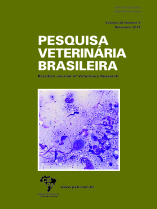 |
|
|
|
Year 2018 - Volume 38, Number 9
|

|
Evaluation of lactatemia and muscle enzymes in Quarter Horses subjected to team ropping with different types of training, 38(9):1856-1862
|
ABSTRACT.- Pereira M.S., Gerardi B., Denadai D.S., Chaves A.A., Barbosa J.P.B., Zanon J.E.O., Gomide L.M.W. & Mendes L.C.N. 2018. [Evaluation of lactatemia and muscle enzymes in Quarter Horses subjected to team ropping with different types of training.] Avaliação da lacatatemia e das enzimas musculares de equinos Quarto de Milha submetidos à prova de laço em dupla com diferentes tipos de treinamento. Pesquisa Veterinária Brasileira 38(9):1856-1862. Departamento de Clínica, Cirurgia e Reprodução Animal, Faculdade de Medicina Veterinária, Universidade Estadual Paulista, Campus de Araçatuba, Rua Clóvis Pestana 793, Bairro Dona Amélia, Araçatuba, SP 16050-680, Brazil. E-mail: marijeronymo@hotmail.com
The aim of this study was to evaluate the influence of different types of training on physical fitness through the determination of blood lactate and serum creatinine kinase, aspartate aminotransferase, and lactate dehydrogenase activity after high intensity and short duration physical exercise. Venous blood samples were obtained from 16 Quarter Horses, divided into two groups: the regular training group (GTR) and sporadic training group (GTE), in seven different moments: 30 minutes before exercise (M0), immediately after the exercise (M1), 30 minutes (M2), one hour (M3), two hours (M4), six hours (M5) and 24 hours (M6) after the exercise. For statistical analysis, data was tested for normality and homogeneity of variances. To compare the groups and times in each group, parametric tests (ANOVA) were used for muscular enzymes activity and not parametric tests (Mann-Whitney and Friedmann) were used to analyze blood lactato (P<0.05). There was no significant difference between groups for any variable. However, within the experimental groups it was possible to observe significant differences between the evaluated moments, in relation to lactate and LDH. In the GTE, significant differences were observed for lactate between M0 and M1, with respective values of 0.90 mmol/L (min. 0.8, max. 1.6) and 3.65 mmol/L (min. 1.0, max. 5,7) and for LDH, where the values described in M6 differed significantly from M0, M1, M2, M3 and M4. In the GTR, significant differences between the experimental moments were observed in relation to LDH, and the values observed in M6 were the lowest and differed significantly from those found in M1, M2, M3 and M4. In conclusion, there was no difference between the fitness of animals regularly trained and those trained sporadically. The low magnitude of elevations of serum CK, AST and LDH activity after exercise and the quick return to baseline values, including the blood lactate observed in both groups, suggest that all of evaluated animals were conditioned and able to perform such physical activity. |
| |
|
|
| |
|
 |